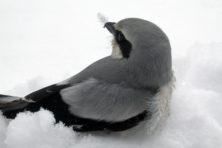Door To Nature: How Birds Survive Winter
- Share
- Tweet
- Pin
- Share

Wild birds that we enjoy seeing at our feeders, woodlands and shorelines have two major periods in their annual existence: the breeding season in summer and the non-breeding season, which up here, is winter.
Their diet is an important reason for where they live during these two periods of the year. Many small songbirds that consume insects must migrate south for the winter where that food is more abundant. Most of our insects are gone during the cold months.
We have a large number of small bird species which live in our area all year and can exist on insects and seeds. These include chickadees, nuthatches, finches, cardinals and the smaller woodpeckers. However, suet and marvel meal are sought by woodpeckers, chickadees and nuthatches, with occasional visits by a brown creeper.
Owls that live here all year eat small rodents plus rabbits, squirrels and sometimes birds. In fact, the uncommon eastern screech owl is a target of the much larger great horned owl. We learned that the smaller owls are not likely to call if they fear a great horned is in the neighborhood.
Another group of birds that can be seen all year are accipiters. This word derives from a Latin verb meaning “to seize.” There are three accipiters known to inhabit Wisconsin, but the largest, the northern goshawk, has become quite rare. The two more common hawks in this group are the Cooper’s and the sharp-shinned.
I have noticed a distinctive sharp-shinned hawk that has visited my front yard on many occasions over the last two years. It is easily identified because of two unusual white-edged feathers on the back of its crown. Recently it swooped through the front yard and caught a male red-bellied woodpecker.
If you have feeders out in your yard and you notice a bird that is present is holding as still as can be, that probably means a hawk is nearby. The accipiters, as well as merlins, another hawk, look for movement that will spring them into flight to catch the bird that tries to fly away.
There are several types of hawks living here in winter. The falcons are the American kestrel, merlin and peregrine falcon. All three nest in the county and if the winter is mild, they may remain here. One rare visitor is the gyrfalcon which breeds way up in the Arctic and Alaska and usually stays in Canada most winters. A friend photographed one near Ellison Bay in January 2020.
Accipiters will remove feathers of the prey that they catch before eating the bird. A merlin, however, will consume everything. Roy told me of watching a merlin catch a downy woodpecker and eating every part of the bird, including the feet. They then regurgitate a pellet of all parts that cannot be digested. That’s what owls do, too.
Winter weather has an effect on many species. I remember the extremely cold and very snowy season of late 2013 into 2014. Lake Michigan was nearly totally frozen. Friends who lived along the shoreline called to tell us of ducks landing in their yards.
Normally we see redheads, common goldeneyes, common mergansers, buffleheads and other waterfowl out on the lake diving for food. That winter they could not do that and came ashore looking for something to eat.
Roy and I drove to Ephraim in mid-March 2014 to photograph the icy shoreline. I was driving so he could concentrate on camera work. As we drove back into our front yard, he photographed a redhead duck on our driveway. We imagined that as this bird flew over, he saw a large, dark, round circle and thought it was a pond.
That same winter we received several calls from people finding eastern screech owls out on the snow in their yards. These birds seek small rodents to eat, but the snow was so deep they could not find any food and were near starvation.
Mild, snowless winters are when we see lingering American robins and cedar waxwings. This year’s annual Christmas bird counts done on December 16 and 17 found over 100 waxwings in both the Sturgeon Bay and Brussels counts. The 1998 Sturgeon Bay count had 224 robins. As long as there are numerous trees loaded with fruit, these birds will find the food they need and will not fly south. The birds appear to eat the fruit, but they are actually eating the seeds inside the berries.
Keep your bird feeders filled so when the snow and cold does arrive, the birds will have their necessary food. It’s also wise to have a heated bird bath which is regularly cleaned and filled with fresh water.
Enjoy the birds of winter wherever you may find them!




